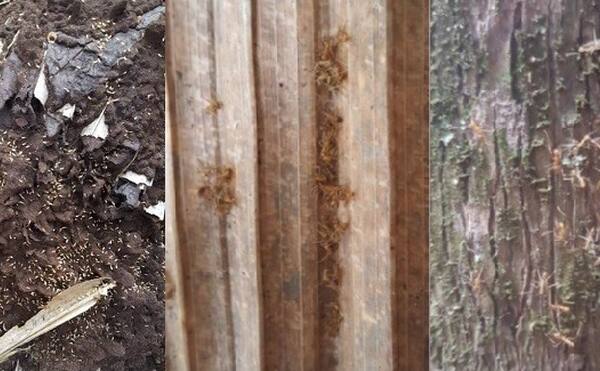Minimising impacts of the invasive yellow crazy ant Anoplolepis gracilipes at the Vallée de Mai UNESCO world Heritage site, Seychelles to preserve its outstanding universal values

Objectives
The Vallée de Mai, at 19.5 ha, is one of the smallest natural World Heritage Sites in the world, and is located on Praslin Island. It is an endemic palm forest that harbours a high number of endemic and threatened species, and is the only site in Seychelles where all six endemic palm species occur.
Yellow crazy ants (YCA) occurred on Praslin for at least 20 years before their spread into the Vallée de Mai in 2009. By the end of 2018, YCA had increased to cover 100 % of the Vallée de Mai. Over this period, research indicated that areas of YCA infestation had reduced native arboreal species of mollusks and geckos. Further observations suggested a precipitous decline in the endemic white slugs and serious declines in endemic palm snail species. Furthermore, numerous YCA attacks have been observed on caecilians, snakes, skinks and geckos, and even black parrot nests. With so many species in decline or under threat, important ecosystem processes such as nutrient cycling, pollination and/or seed dispersal were highly likely to be negatively impacted. The YCA invasion in the Vallée de Mai is the most serious threat the site has faced so far.
The overall objective of this project was to prevent further impacts on the native and endemic biodiversity and Outstanding Universal Value of the Vallée de Mai from highly invasive YCA by significantly reducing their abundance and distribution across the site.
Results
In preparation for the project, a detailed and critical analysis of methods applied elsewhere in the world to control YCA was undertaken. The methods were assessed according to their effectiveness, costs and benefits, including investigation and consideration of non-target impacts. After this review and experts consultation, it was decided to use a combination of hand-cast fipronil-based bait pellets (AntOff, whose impacts on other species were expected to be low) and liquid fipronil bait (Termidor, which has very low toxicity to mammals) in bait stations along the waterways in the Vallée de Mai. The designed baiting method for the Vallée de Mai consisted of deploying AntOff at a rate of 5kg/ha via hand baiting, using teams of four people spaced 10 m apart. Polygons in GIS uploaded to GPS units gave the field teams a point of reference to work to. They followed polygon edges to ensure an adequate coverage. All treatment activities were tracked on GPS devices which allowed identification of any gaps that would need to be re-baited. Four baiting campaigns took place in August 2019, November 2019, May 2020 and October 2020. The 3rd and 4th baiting included the buffer zone in order to prevent YCA from re-invading the Vallée de Mai.
The survey results from November 2020, after the fourth baiting, showed the lowest YCA numbers and distribution in the Vallée de Mai since monitoring started in 2010, delivering the scientific evidence for the success of this project.
Monitoring so far indicates potential recovery of native fauna, although this will require more time and further monitoring. Based on the baiting and monitoring work done, local removal and long-term control of YCA in the buffer zone around the Vallée de Mai, and targeted incursions within the site itself, will need to continue to ensure the long-term success of this project.
Committee Decisions
The World Heritage Committee,
- Having examined Documents WHC/19/43.COM/13 and WHC/19/43.COM/13.Add,
- Approves the budget adjustments within the World Heritage Fund to increase the budget line “International Assistance – Conservation & Management” by US$ 110,468, this amount being covered by the budget lines “Cooperation with other Conventions & Organizations” (for US$ 5,000) “Information Management” (for US$ 32,000), “Periodic Reporting-Global” (for US$ 30,000) and “Periodic Reporting-Asia” (for US$ 10,000), as well as by the funds from savings on prior year’s obligations (for US$ 33,468);
- Decides to approve the following International Assistance requests:
- “Optimising usage control and monitoring for the conservation and management of pelagic ecosystems in the Galápagos Marine Reserve” (Ecuador), for an amount of US$ 59,975 under the Conservation & Management-Nature budget;
- “Request for International Assistance for the evaluation of the 2012-2018 management plan and the preparation of the new management plan (2019-2024) for the Historic Centre of Agadez” (Niger), for an amount of US$ 42,385 under the Conservation & Management-Culture budget;
- “Conservation, revitalization and sustainable cultural development of the Temple of la Limpia e Inmaculada Concepcion de la Antigua Guatemala” (Guatemala), for an amount of US$ 69,791, namely US$ 68,083 under the Conservation & Management-Culture budget and US$ 1,708 under the Conservation & Management-Nature budget as authorized by paragraph 240 of the Operational Guidelines;
- “Minimising impacts of the invasive yellow crazy ant Anoplolepis gracilipes at the Vallée de Mai UNESCO World Heritage site, Seychelles, to preserve its outstanding universal value” (Seychelles), for an amount of US$ 96,850 under the Emergency assistance budget;
- Recalling Decision 42 COM 13, paragraph 4, strongly appeals to all States Parties to make voluntary contributions for International Assistance by choosing among the options described in Resolution 19 GA 8.